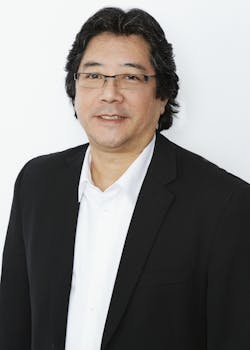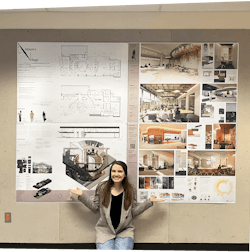How IIDA’s Student Mentoring Program Shaped a Career at IA Interior Architects
Key Highlights
- The IIDA Student Mentoring Program can foster lasting professional relationships that can evolve into career-shaping collaborations.
- Real-world exposure through mentorship helps students bridge the gap between academic learning and industry practice.
- Forward-thinking guidance empowers emerging designers to create adaptable, future-ready spaces that reflect evolving client needs.
Building a career is as much about knowledge as relationships. A successful career weaves together both.
In rare instances, the relationships fostered between the mentor and mentee lead to a synergetic relationship that benefits both parties for years to come. That’s exactly what happened when David Kutsunai, a managing director at IA Interior Architects, mentored Jenna Morrison, a Bellevue College student, through the IIDA Student Mentoring Program.
i+s: What motivated you to participate in the IIDA Student Mentoring Program?
Jenna Morrison: Ever since starting college, I’d heard time and time again, network, network, network. Both in business school and then in interior design school. I never liked networking, though, or even the concept of it. It seemed fake and superficial. When I started design school, however, I kept hearing this mantra over and again from alumni who’d landed jobs through networking and from professors and their past students who’d gotten their jobs this way. So, as I went into my third year of the program, I decided to bite the bullet and sign up.
David Kutsunai: Historically, mentoring has always been a top-down process. Those who know the most and have more experience, mentored those “below” them. The youth today have had access to more information than I ever did. They have a better command of technology and often are more well-traveled than I. Thus today, an intern or recent graduate can teach me as much as I can teach them.
i+s: How did experiences like touring Amazon’s The Spheres shape your perspective as a designer and leader?
Morrison: Dave was very willing to not only set up different video calls to chat about his industry experience but also offered to give me a tour of Amazon’s The Spheres and a tour of his firm’s office. In addition, he also reviewed my portfolio and gave me feedback on how to walk someone through my portfolio in an interview setting. Because of this, I ended up landing an internship at NBBJ that summer.
Kutsunai: As I now manage staff at all levels, it is important to understand the skill level of recent graduates, what their passions for the profession are, why they want to be a designer, what some of their expectations and trepidations are, and generally, what their perspectives are of the world and their future.
Our various sessions, conversations, site visits and meals together, have provided additional insight to all of the above. In Jenna’s case, her ability to communicate thoughts, demonstrate her passions and vulnerabilities, and be unintimidated in our interactions, further provided insight to and quite frankly, encouragement for the next generation coming into the profession.
i+s: Share a key piece of advice David gave you that you’ll carry into your career.
Morrison: Dave really pushed me to think outside the box and to not just think of my project in terms of where society is here and now but be forward-thinking in how I designed my space. Don’t just design a space with the unrealistic expectation that the client will continue to use that space as it is for the next ten years, or that they won’t want to give it a refresh in that time. Design the space for change so that it can adapt to the client’s changing needs and tastes over time. I think this really stuck with me as not only food for thought, but a goal to bring into whatever project I’m working on.
I make it a point to not participate in the hiring process of anyone I teach or mentor so as not to personally influence a decision. The choice to offer Jenna a position was made solely by other principals and designers in our office and she has already made great contributions on her various projects.
- David Kutsunai
i+s: How do you see IIDA’s program influencing the future pipeline of design talent?
Kutsunai: Mentorship programs help to break down communication barriers between students and professionals. Connections locally or nationally allow for exposure to many different areas of design and how it is done. While this can only increase the quality of design talent coming into the profession, it can in turn influence and shape how design practices think about the types of talents they are needing for a shifting industry and how and where they recruit. Communication with schools, then in turn, can influence curriculum programs to best fuel the profession with the talent needed. Programs like these can help to continue the communication between design education, new talent, and professional design firms.
i+s: What was the most rewarding moment in your mentoring relationship with Jenna?
Kutsunai: I have two “most rewarding moments.” The first is when she notified me that she was hired as a summer intern with one of the largest architectural firms in the country. We worked on her portfolio and discussed tips for interviewing that she leveraged to win a coveted position. The second was when our own firm decided to interview her and offer her a position upon her graduation. I make it a point to not participate in the hiring process of anyone I teach or mentor so as not to personally influence a decision. The choice to offer Jenna a position was made solely by other principals and designers in our office and she has already made great contributions on her various projects.
i+s: How has your ongoing mentor/mentee relationship demonstrated the lasting value of the IIDA Student Mentoring Program?
Kutsunai: The relationship Jenna and I developed through the IIDA Student Mentoring Program led her to ask me to continue our relationship via an advisory role on her final Senior Capstone Project. I now continue to work with Jenna in a professional capacity where we continue to actually mentor each other.
Morrison: This experience changed my mind about networking, because I sensed that Dave genuinely wanted to help me in my journey of design and gave up a lot of time in his day to answer my plethora of questions.
The following fall I started my Capstone project and one of the requirements was to get collaborators to help give feedback and review our projects throughout the two quarters. So, I asked Dave to be one of my collaborators as I was excited to get his feedback throughout my project which was focused on workplace/hospitality, one of his firm’s specialties.
i+s: How does mentoring align with IA’s values and culture of supporting emerging designers?
Kutsunai: Accelerating change in the businesses of our clients has become their biggest challenge. Our designers at every level are now leveraged as advisors who can lead and problem solve, not anymore as designers who design what they are asked to design. Knowledge has to be gained, shared, and utilized in the process of design like never before. Thus supporting, mentoring, teaching, and learning have become essential drivers in our culture of innovation.
i+s: How did working on real-life projects impact your understanding of the design process and client relationships?
Morrison: Finally working within the context of a firm, instead of being in a school bubble, was a great experience to understand how the industry works and how it is to work in a team. At school, you’re siloed in solo projects, so having that exposure to work on real-life projects and learning from the other designers and interactions with clients to navigate client feedback while pushing them forward was cool to see.
This positive experience of meeting someone who was genuinely invested in the next generation of designers made me more comfortable asking questions and networking.
- Jenna Morrison
i+s: How did the program impact your confidence as a designer entering the industry?
Morrison: The program was very beneficial in changing my mind about networking and mentorship overall. This positive experience of meeting someone who was genuinely invested in the next generation of designers made me more comfortable asking questions and networking.
i+s: Why should someone participate in IIDA’s Student Mentorship Program?
Morrison: Why not? It’s a much better way to get to know someone in the industry than one-off networking events alone. I think it’s also a great starting point for practicing asking questions. You don’t know what you don’t know, so having someone who’s willing to answer your questions one-on-one is a great learning opportunity.
Kutsunai: Please find the time to participate! You will not only help to upgrade the talent coming into our profession, but you will also learn some unexpected things through the process, thereby increasing the value of your own participation. You may also find a talented individual that your own firm can benefit from.
The future of interior design lies with the next generation—and through IIDA’s Student Mentoring Program, students gain the mentorship and connections needed to shape a stronger industry.
Learn more about the IIDA's Student Mentoring Program before the next cohort opens.
Program Guidelines
The IIDA Student Mentoring Program is segmented into mentoring sessions over nearly two months.
Session 1: Kickoff & Goal-Setting
- Introduce yourselves (background, school/company, career path).
- Share goals and expectations for mentoring.
- Students: research mentor/company and set session goals.
- Mentors: share career path, experiences, and resources.
- Confirm dates/times for future sessions.
Session 2: Career Tools & Skill-Building
- Review and critique the student’s resume, portfolio, website, or LinkedIn.
- Provide feedback on a project or competition entry.
- Conduct a mock interview.
- Work together on personal branding (strengths, uniqueness, audience).
- Set goals and confirm logistics for final session.
Session 3: Real-World Experience
- Tour a project or firm (in-person or virtual).
- Introduce the student to colleagues and different roles.
- Participate in a team brainstorming or design review.
- Give the student a firsthand look at day-to-day professional practice.
After Sessions: Stay Connected
- Send thank-you notes.
- Connect on LinkedIn/social media.
- Follow each other’s company/school updates.
- Keep in touch through newsletters or IIDA events.
About the Author
Lauren Brant
Editor, i+s and BUILDINGS
Lauren Brant is an editor at both i+s and BUILDINGS. Prior to joining Endeavor Business Media, she served as deputy news editor at a daily and editor of a weekly newspaper. She is an award-winning editor and writer.




